As if getting set on fire and tossed into space wasn’t enough, new research finds evidence that after the Chicxulub impact, dinosaurs were also the victims of a massive global tsunami and worldwide earthquakes. Plus, the Milky Way’s stellar graveyard, a new timeline for the Moon’s formation, and this week in space history, we look back at the Meteosat program.
Podcast
Show Notes
Found: Hiding orbits of dead stars
- The University of Sydney press release
- “The Galactic underworld: the spatial distribution of compact remnants,” David Sweeney, Peter Tuthill, Sanjib Sharma, and Ryosuke Hirai, 2022 August 25, Monthly Notices of the Royal Astronomical Society
Dinosaurs washed away in largest wave to wrap Earth
- GSA press release
- University of Michigan press release
- “The Chicxulub Impact Produced a Powerful Global Tsunami,” Molly M. Range et al., 2022 October 4, AGU Advances
Shock-darkened rocks found in near-Earth asteroid
- The University of Arizona press release
- “Physical Characterization of Near-Earth Asteroid (52768) 1998 OR2: Evidence of Shock Darkening/Impact Melt,” Adam Battle et al., 2022 October 4, The Planetary Science Journal
Early collision may have formed Moon quickly
- Durham University press release
- Giant impact could have formed the Moon more rapidly, scientists reveal in new simulations (EurekAlert)
- “Immediate Origin of the Moon as a Post-impact Satellite,” J. A. Kegerreis et al., 2022 October 4, The Astrophysical Journal Letters
This Week in Space History: The Meteosat Program
Transcript
The spoopy season is upon us, and that means that we’re picking the scarier stories today. Both Dr. Pamela and I are elder goths at heart, so we thrive just a little on destruction. And today, we have even more destruction than yesterday.
Today, we have dead stars orbiting the Milky Way. We have even more destruction around the Chicxulub dinosaur-killing impact event. And then we take a bit of the death out of the death and destruction and look at how crystals get shock-darkened and how perhaps the Moon formed more quickly than thought.
Finally, we’ll mostly come back down to a nice gentle Earth while Erik Madaus looks back at the beginnings of the Meteosat program as a follow-up to this week’s interview.
All this and more is coming at you right here on the Daily Space.
I am your host, Beth Johnson, and we are here to put science in your brain.
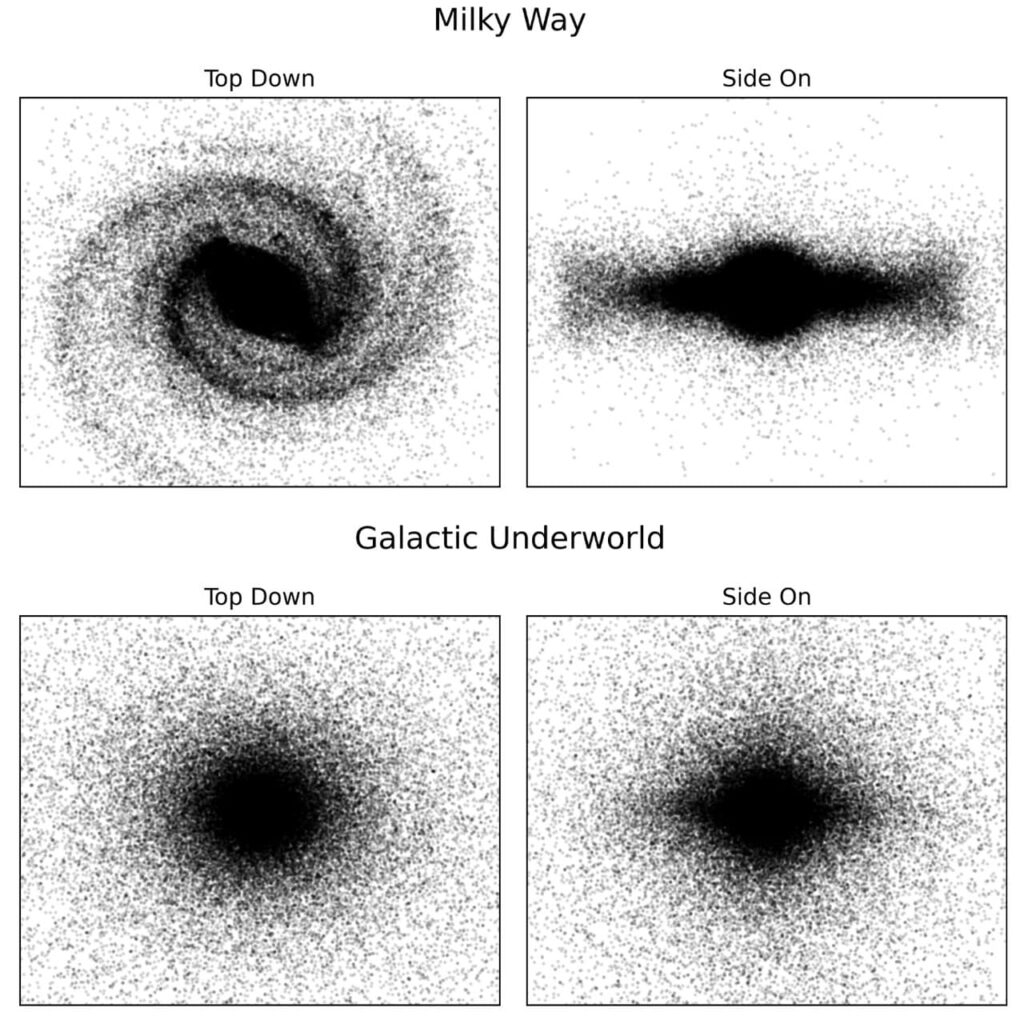
In our last episode, we brought you tales of a vampiric star and its thrall… or rather its companion star. In this episode, we are keeping with the Halloween season theme and exploring the hidden places where stars go when they die.
No seriously, this is a real scientific problem.
Astronomers haven’t had a good understanding of where the remnants of large stars end up. Put simply – there are a whole lot of missing black holes and neutron stars that were kicked out of supernovae.
But what’s missing can sometimes be found. In a new paper in the Monthly Notices of the Royal Astronomical Society, researchers led by David Sweeney use detailed galactic models to discover where neutron stars and black holes live out eternity.
This model had to take into account many different factors, but the largest challenge of all was sorting out what happens during the supernovae explosions.
It turns out many to perhaps all of these explosions are asymmetric. While a glowing nebula – a supernova remnant – marks the original star’s location, any stellar remnant is cast out in a random direction. And they’re flying fast. This team estimates that 30% of the stellar remnants are flung away with sufficient energy to leave our galaxy.
The objects that don’t escape are generally kicked into highly-elliptical orbits that stray in and out of the main disk of the Milky Way. The team refers to this family of orbits as the ‘galactic underworld’.
We are used to seeing only our galaxy’s living stars along with its expansive flat disc and bulging spheroid in the center. The expected distribution of dead stars is very different. It is basically a giant blob with just a hint of a disk. And this blobby result should be testable. Sweeney explains: The most exciting part of this research is still ahead of us. Now that we know where to look, we’re developing technologies to go hunting for them. I’m betting that the ‘galactic underworld’ won’t stay shrouded in mystery for very much longer.
We wish this team well in their discoveries, but we would remind them dead men tell no tales, and we’re not entirely sure we want to know what yarns dead stars may try to weave.
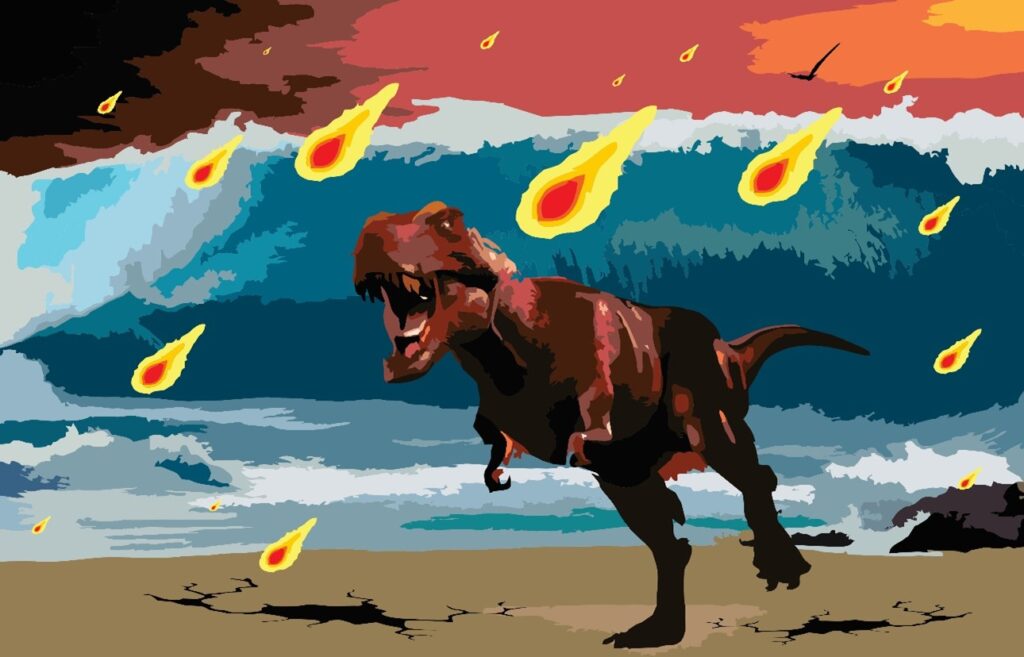
While dead men may tell no tales, dead dinosaurs have inspired countless dissertations, some of them even telling the story of how a large asteroid hit our world, sending shock waves radiating out; and sending dirt, plants, and very dead dinosaurs shooting up.
That there was at least one massive impact – the impact that formed the Chicxulub crater – is scientifically well accepted. Where we struggle is in understanding just how much additional chaos took place during this dinosaur-eradicating event. Research in North America has found evidence of tsunamis racing across the landscape, but that evidence is based on just one fossil site. We have to wonder just what else is out there waiting to be found.
For me, this “what else is there” question is just something to think about now and then. For researcher Hermann Bermúdez, this question has been transformed into a career, as he searches out geologic evidence about what happened when the asteroid struck.
This work all started in 2014 when he was doing fieldwork on the coast of Colombia’s Gorgonilla Island. In looking at our world’s history in the sedimentary rocks, he noticed layers of material filled with small glass beads and a distinct kind of rock shard – tektites – that are ejected during an asteroid impact. These materials were found at the same layer of history as the KT-boundary that marks the end of the dinosaurs.
In general, finding evidence of an asteroid impact when we know there was an asteroid impact seems… unsurprising. The thing is, these particular layers were at the bottom of the ocean when that impact took place.
According to the Geological Society of America’s press release on this research: The rocks exposed on the coast of Gorgonilla Island tell a story from the bottom of the ocean—roughly 2 km down. There, about 3,000 km southwest of the site of the impact, sand, mud, and small ocean creatures were accumulating on the ocean floor when the asteroid hit. Layers of mud and sandstone as far as 10–15 meters below the sea floor experienced soft-sediment deformation that is preserved in the outcrops today.
This data, in combination with observations Bermúdez has made at numerous other sites, paints a picture of a mega earthquake that may have shaken the Earth for weeks or even months.
This work is complementary to a new study led by Molly Range that is coming out in AGU Advances. Her work shows that the tsunami created by the impact should have circled the globe within 48 hours, and the initial wave would have stood more than 100 meters tall as it rolled across what is now the Gulf of Mexico.
Put simply, that asteroid caused a really bad couple of days that ruined the atmosphere for… well, how long is still up for debate.
Okay, it may be Halloween season, but that is probably more death and destruction than any of us needed today.
Let’s switch gears to discuss the… well… um… let’s not switch gears to look at the implications of certain meteorites and the rather violent event that formed our Moon… and then… Let’s switch gears to look at recent and historic launches with Erik Madaus.
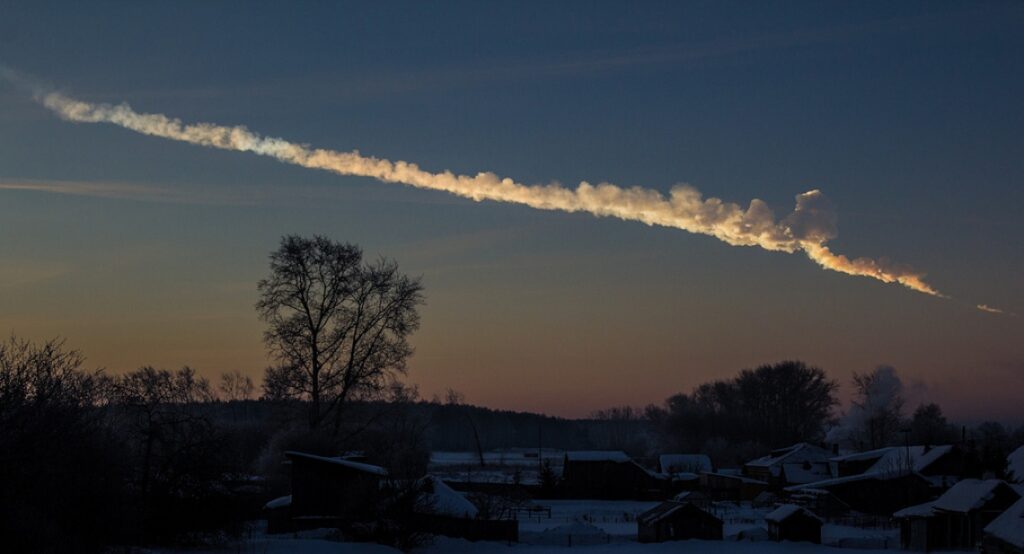
Not every impact event is a massive extinction-level event. More often, the asteroid or comet fragments that make it through our atmosphere are small and usually burn up before they hit the ground. However, there is a lot of in-between when it comes to meteorite sizes: between ‘extinction event’ and ‘burns up in the atmosphere’ is a range of impactors. One such middle-of-the-road event was the Chelyabinsk meteor in 2013 – not large enough to leave a crater but large enough to cause a sonic boom that destroyed windows.
However, along with a bunch of fragments, the Chelyabinsk meteor also left behind an important mystery. The meteorites were an uncommon type, containing dark veins in the rocks left by a process called ‘shock darkening’.
Until recently, scientists didn’t know of any asteroid from which these types of meteorites could originate. Now, in a new paper published in the Planetary Science Journal and led by Adam Battle, a possible asteroid source has been discovered – asteroid 1988 OR2. Battle explains: Shock darkening is an alteration process caused when something impacts a planetary body hard enough that the temperatures partially or fully melt those rocks and alter their appearance both to the human eye and in our data.
This particular near-Earth asteroid is 2.4 kilometers wide and last made a close approach to Earth back in April 2020, and while it’s not the first asteroid with evidence of shock darkening to be found, it is the closest. The others were all in the main asteroid belt, closer to Mars and Jupiter. Co-author Vishnu Reddy notes: Impacts are very common in asteroids and any solid body in the solar system because we see impact craters on these objects from spacecraft images. But impact melt and shock-darkening effects on meteorites derived from these bodies are rare. Finding a near-Earth asteroid dominated by this process has implications for impact hazard assessment.
At first glance, asteroid 1998 OR2 seems to be an ordinary chondrite asteroid, containing olivine and pyroxene and appearing lighter relative to other asteroids. However, a classification tool used by the research team suggested that the asteroid was carbonaceous, and that discrepancy was the crux of the question. Carbonaceous asteroids are usually dark and featureless. But as Battle further explains: The asteroid is not a mixture of ordinary chondrite and carbonaceous asteroids, but rather it is definitely an ordinary chondrite, based on its mineralogy, which has been altered – likely through the shock darkening process – to look like a carbonaceous asteroid to the classification tool.
Mineralogy is important to planetary defense. Reddy notes: …ordinary chondrite asteroids can appear as carbonaceous in our classification tools if they are affected by shock darkening. These two materials have different physical strengths, which is important when trying to deflect a hazardous asteroid.
We would not enjoy expecting a rubble pile and getting something far more solid and more difficult to move if we were trying to deflect a potentially hazardous asteroid., so this research is vital to planetary defense.
Just ask the dinosaurs… oh, wait.

Speaking of impactors, let’s talk about the Big One that occurred billions of years ago when a Mars-sized body hit the Earth and formed the Moon. The most recent understanding of this process is that an object scientists have named Theia collided with the early Earth about 4.5 billion years ago. The collision was but a graze or a flesh wound, ejected pieces of both bodies out into space, and then some pieces formed the Moon and the rest rejoined the proto-Earth.
Rocks taken from the Moon by the Apollo astronauts had similar compositions to rocks here on Earth, adding to the evidence that the two bodies shared bits and pieces after the collision. And the process was thought to have taken millennia to reach the current size and shape of the Earth-Moon system. However, in a new paper published in The Astrophysical Journal Letters and led by Jacob Kegerreis, supercomputer simulations found that the Moon was almost immediately placed into orbit around the Earth.
Study co-author Vincent Eke explains: This formation route could help explain the similarity in isotopic composition between the lunar rocks returned by the Apollo astronauts and Earth’s mantle. There may also be observable consequences for the thickness of the lunar crust, which would allow us to pin down further the type of collision that took place.
At this point, we need more lunar samples to find more clues about the impact that led to the Moon’s creation, and from there, we can learn more about Earth’s history as well.
Coming up, Erik brings us this week in space history.
This Week in Space History
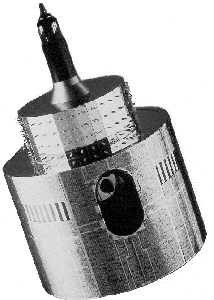
To go along with the interview from earlier this week, today I’m going to talk about the history of the Meteosat program.
The gentleman Beth interviewed was from Eumetsat, which currently operates the satellites, but the actual program predates even the European Space Agency (ESA). Meteosat was started in 1972 under the European Space Research Organization (ESRO), one of the predecessors of ESA, from a slightly earlier concept from the French space agency CNES.
The basic premise of the Meteosat program was similar to many other projects at ESRO, namely a space capability that Europe could use without depending on anyone else. Meteosat would provide operational weather forecasting and other services including data collection, data relay, and laser ranging.
What they came up with was a spin-stabilized satellite 2.1 meters in diameter and weighing just under 700 kilograms at launch. The first generation had one main instrument, a large telescope with visible and infrared detectors. Different spacecraft in the first generation were also fitted with one-off instruments, including a laser retroreflector for timing and an electron spectrometer for space environment sensing.
Each Meteosat also had a transponder to collect data from ground-based sensors around the world. It would relay this data to where it needed to go.
Meteosat 1 was launched in November 1977 on an American Delta rocket, but Europe’s Ariane rockets launched the other satellites. Meteosat 1 operated from zero degrees longitude over the equator in geostationary orbit, providing images of most of Europe and the Middle East, all of Africa, and as far west as South America. All subsequent satellites have operated from this position.
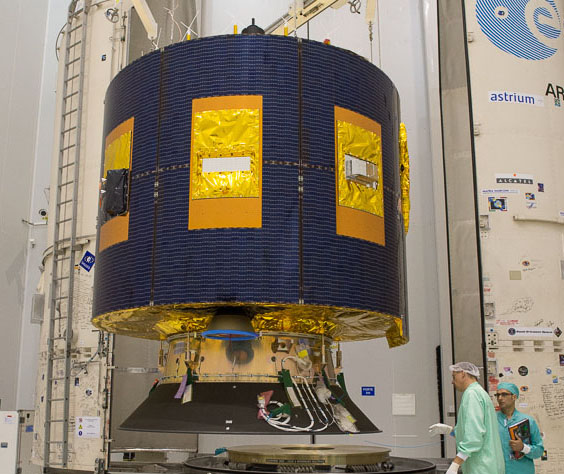
After the launch of Meteosat 2, the newly formed European Space Agency met and decided that the operation of the satellites would be handled by a new organization, the European Organization for the Exploitation of Meteorological Satellites or Eumetsat. At the same time, the Meteosat Operational Program was announced. It would consist of Meteosats 4 through 7, which would be improved versions of the original satellites. Eumetsat is similar to the National Oceanic and Atmospheric Administration (NOAA) in the U.S.
The agreement came into force in 1986, and the next year Eumetsat took responsibility for the satellites, contracting with ESA to build new satellites. Starting in 1995, responsibility for everything related to Meteosat was given to Eumetsat. At this time, Eumetsat also began planning the second generation of the constellation.
Meteosat has so far seen two generations of spacecraft, with the first seven satellites active from 1977 through 2017 and the second from 2002 to the present. The Meteosat Second Generation started in 2002 and consisted of four satellites. Each of the new satellites is three times larger than the first generation and has much more capable instruments. The second generation will serve until 2033.
Since 1991, two Meteosats have been operated simultaneously, one over Europe and the other over India. Starting with Meteosat 5, the older of the two Meteosats in service has typically been stationed over India.
Meteosat was started for Europe, but the satellites have helped out other countries as needed. For example, in 1991, Meteosat 3 was moved west for NOAA, as a temporary replacement for GOES-West. This temporary assignment ended in 1995.
At the end of its main mission, Meteosat 5 was moved to the Indian Ocean to study air pollution in Southeast Asia for two years, after which it acted as a data relay satellite until 2007. This data relay role has continued with the other Meteosat satellites.
Eumetsat is currently developing the third generation of Meteosat satellites. The first of this generation of satellites could launch as soon as this year; in fact, it’s on a boat to its launch site in French Guiana as we’re recording this episode.
Statistics
And now, for some statistics.
The number of toilets in space is nine: four on the ISS, one on Soyuz MS-22, one on Crew Dragon Endurance, one on Crew Dragon Freedom, one on Tianhe, and one on Shenzhou 14.
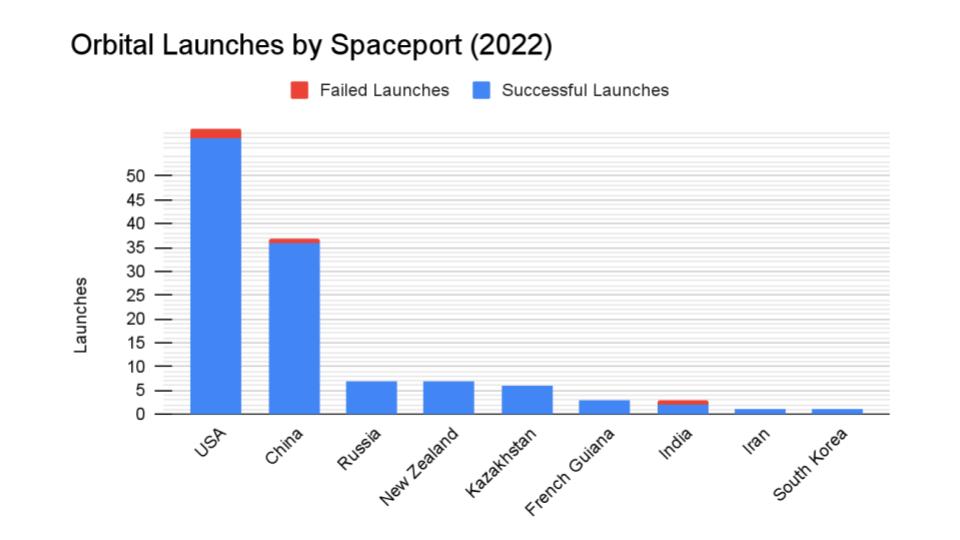
We keep track of orbital launches by launch site, also called spaceport. Here’s that breakdown:
USA: 60
China: 37
Russia: 7
New Zealand: 7
Kazakhstan: 6
French Guiana: 3
India: 3
Iran: 1
South Korea: 1
From those 125 launches, a total of 1,960 spacecraft have been put into orbit in 2022, with 1,508 of them being Starlinks, which is almost eight out of every ten satellites launched this year to date.
Your random space fact for this week is that Meteosat 1 was the first satellite in a geostationary orbit capable of imaging water vapor.
This has been the Daily Space.
You can find more information on all our stories, including images, at DailySpace.org. As always, we’re here thanks to the donations of people like you. If you like our content, please consider joining our Patreon at Patreon.com/CosmoQuestX.
Credits
Written by Pamela Gay, Annie Wilson, Beth Johnson, Erik Madaus, and Gordon Dewis
Hosted by Pamela Gay, Beth Johnson, and Erik Madaus
Audio and Video Editing by Ally Pelphrey
Content Editing by Beth Johnson
Intro and Outro music by Kevin MacLeod, https://incompetech.com/music/


 We record most shows live, on Twitch. Follow us today to get alerts when we go live.
We record most shows live, on Twitch. Follow us today to get alerts when we go live.